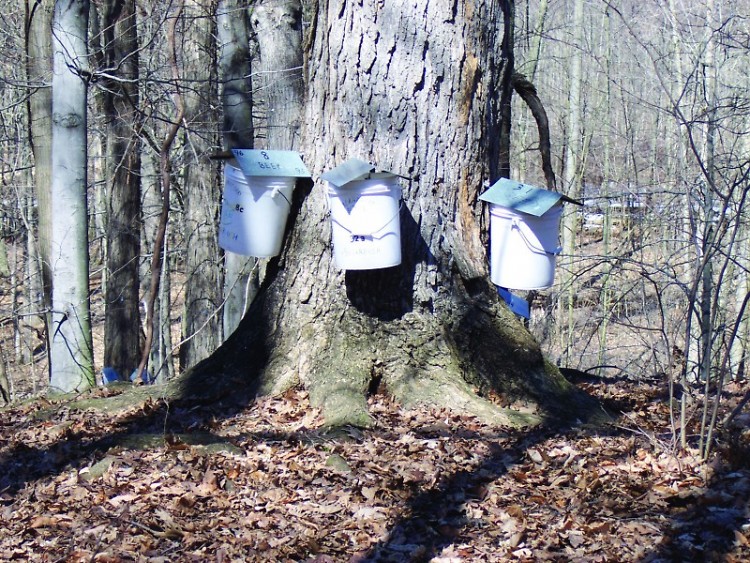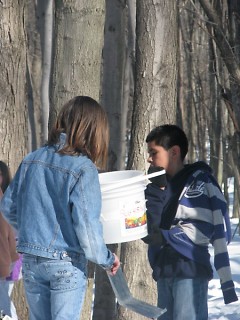It's that time of year. While the land around us continues to be covered with a deep blanket of snow, there's a shift in the trees. With warmer days and cold, clear nights, the trees stretch their hibernating limbs and the sap starts to flow.
While a variety of trees and species can be tapped to produce syrup, it's the sugar maple tree (Acer saccharum) that produces that sweet, vanillin flavored syrup we all know as REAL maple syrup. The range in which this tree grows is quite limited. The sugar maple grows as far east across Canada into Vermont, as far west as Wisconsin, and as far south as Georgia - making a heart-shaped area in the northeast in which superior maple syrup can be produced. Certainly other maples - even birches - can be (and are) tapped for the sap to boil into syrup but it's the sugar maple that is the star of this show commonly referred to as Sugarbush.
A sweet way to teach kids about Michigan's natural landscape and food traditions
Holly Orions, environmental educator at West Michigan Academy of Environmental Science (WMAES) speaks enthusiastically about using the maple syrup process to teach kids about Michigan ecology and history. "At WMAES, our March theme is Natural History and we focus on the history of our property as a once-operable Sugarbush (we have the old rock foundation to prove it), the history of Native American involvement, and then the Michigan history of maple syrup making."
As soon as the tree's sap begins to flow, students choose appropriate-sized trees, tap the trees with spiles and use buckets to collect the sap. Orions explains, "All classes tap a tree or two and then check the buckets collecting the sap throughout the season. Then we collect the buckets with the high school students and boil it here at school."
"Once it warms up, we'll have a big old pot out in the woods and over the fire we'll boil up sap as a demonstration site. It's fun, though I am still hoping someday to get that fancy evaporator I have yearned for," laughed Orions. "Then, the students come out for taste testing and we have outdoor fun activities planned for our own little Sugarbush celebration."
Did you know it takes nearly 40 gallons of sap to make one delicious gallon of maple syrup? If you don't, Orions suggests visiting their school on March 24th as the students demonstrate what they've learned. "We have an evening program "Makin' Maple Syrup" on March 24th from 6:30-8pm that is open to the public." says Orions.
This opportunity for the students to showcase their learning about the sugar maple and the syruping process is rooted in WMAES philosophy of outdoor, experiential learning. “Our students learn from the ground up! It is important that students know about the place where they live, and [projects like this at] WMAES allows them that opportunity,” says Orions.
Visit Sugarbush at Blandford Nature Center
Of course, if you cannot make it over to WMAES for the students' presentation on Sugarbush, Blandford Nature Center will be featuring the maple syrup process for the entire month of March. One of Grand Rapids' most favorite springtime festivals, this month-long Sugarbush is one of the largest in Michigan and draws well over 10,000 visitors from around the area during the month of March.
During Blandford's Sugarbush visitors will see firsthand how Michigan's early peoples and settlers boiled up the sap to make into candies and sugar. Visitors can even see seasoned "operators" running their restored sugarhouse cooking up Blandford's own private batch of maple syrup that's available for purchase in the visitor's gift shop.
Blandford Sugarbush programming takes place all month long and weekday programming is available for groups. Saturday group tours are available to the public for $3/ppn from 12-4pm. Weekday tours groups are for 15 or more people and require reservations. For large groups (10+) on Saturdays Blandford staff require a reservation.
In addition to the Sugarbush Festival at the center, Blandford is hosting its annual Pancake Breakfast on Saturday, March 26th from 9am-12pm at CA Frost Elementary School. Blandford volunteers and Environmental School students will be flipping flapjacks on the griddle and serving up sides of sausage -- all featuring Michigan maple syrup, of course. Cost of the Pancake Breakfast is $5 for kids and $10 for adults (price includes admission to the Sugarbush Festival at the center).
Interested in learning how to tap sugar maples to have your own Sugarbush?
On Sunday, March 6th, 2011 from 2:00 - 3:30 pm the Wittenbach/Wege Agriscience and Environmental Education Center in Lowell is hosting a class to teach participants how to collect and process sugar maple sap to then make into maple syrup. Included in the registration fee are handouts, 3 spiles and 3 sap jugs – everything you need to begin tapping that very day! Cost is $25 per family and registration is required. Contact the center to see if space is available for this program.
Do you host your own Sugarbush in your backyard? We'd love to feature your experience here on The Local Beet for The Rapidian! Drop us a line!
Think Michigan maple syrup is only good on pancakes?
Think again. Follow The Local Beet on The Rapidian throughout the Sugarbush season of March for fun Michigan maple syrup recipes and cooking tips. How do you use maple syrup in your kitchen?
The Rapidian, a program of the 501(c)3 nonprofit Community Media Center, relies on the community’s support to help cover the cost of training reporters and publishing content.
We need your help.
If each of our readers and content creators who values this community platform help support its creation and maintenance, The Rapidian can continue to educate and facilitate a conversation around issues for years to come.
Please support The Rapidian and make a contribution today.




Comments
So glad you did a story on this! I was putting it in the calendar for this week's Catalyst Radio and fondly remembering back in college, when we used to tap maple trees in the woods behind the dorms.
How many gallons do the students tap each year before the sap is reduced to syrup?
Not sure exactly how many gallons the kids will end up with at WMAES ... it really is dependent on the season. Having had been the Director at Blandford Nature Center for two SugarBush seasons, the sap we collected ranged in the environs of a few hundread gallons. This was collected over several weeks and was boiled down to end up with about 60 gallons of syrup. It really puts into perspective how much work goes into the syruping process relative to yield, especially when considering the cost per quart!!!!